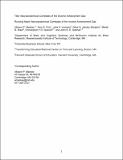| dc.contributor.author | Mackey, Allyson | |
| dc.contributor.author | Finn, Amy Sue | |
| dc.contributor.author | Leonard, Julia Anne | |
| dc.contributor.author | Gabrieli, John D. E. | |
| dc.contributor.author | Jacoby-Senghor, Drew S. | |
| dc.contributor.author | West, Martin R. | |
| dc.contributor.author | Gabrieli, Christopher F. O. | |
| dc.date.accessioned | 2015-04-23T13:56:20Z | |
| dc.date.available | 2015-04-23T13:56:20Z | |
| dc.date.issued | 2015-04 | |
| dc.date.submitted | 2015-01 | |
| dc.identifier.issn | 0956-7976 | |
| dc.identifier.issn | 1467-9280 | |
| dc.identifier.uri | http://hdl.handle.net/1721.1/96726 | |
| dc.description.abstract | In the United States, the difference in academic achievement between higher- and lower-income students (i.e., the income-achievement gap) is substantial and growing. In the research reported here, we investigated neuroanatomical correlates of this gap in adolescents (N = 58) in whom academic achievement was measured by statewide standardized testing. Cortical gray-matter volume was significantly greater in students from higher-income backgrounds (n = 35) than in students from lower-income backgrounds (n = 23), but cortical white-matter volume and total cortical surface area did not differ significantly between groups. Cortical thickness in all lobes of the brain was greater in students from higher-income than lower-income backgrounds. Greater cortical thickness, particularly in temporal and occipital lobes, was associated with better test performance. These results represent the first evidence that cortical thickness in higher- and lower-income students differs across broad swaths of the brain and that cortical thickness is related to scores on academic-achievement tests. | en_US |
| dc.description.sponsorship | Bill & Melinda Gates Foundation | en_US |
| dc.description.sponsorship | National Institutes of Health (U.S.) (Grant F32 HD079143-01) | en_US |
| dc.description.sponsorship | National Institutes of Health (U.S.) (Grant F32 MH095354-01) | en_US |
| dc.language.iso | en_US | |
| dc.publisher | Sage Publications/Association for Psychological Science | en_US |
| dc.relation.isversionof | http://dx.doi.org/10.1177/0956797615572233 | en_US |
| dc.rights | Creative Commons Attribution-Noncommercial-Share Alike | en_US |
| dc.rights.uri | http://creativecommons.org/licenses/by-nc-sa/4.0/ | en_US |
| dc.source | Mackey | en_US |
| dc.title | Neuroanatomical Correlates of the Income-Achievement Gap | en_US |
| dc.type | Article | en_US |
| dc.identifier.citation | Mackey, A. P., A. S. Finn, J. A. Leonard, D. S. Jacoby-Senghor, M. R. West, C. F. O. Gabrieli, and J. D. E. Gabrieli. “Neuroanatomical Correlates of the Income-Achievement Gap.” Psychological Science (April 20, 2015). | en_US |
| dc.contributor.department | Massachusetts Institute of Technology. Department of Brain and Cognitive Sciences | en_US |
| dc.contributor.department | McGovern Institute for Brain Research at MIT | en_US |
| dc.contributor.mitauthor | Mackey, Allyson | en_US |
| dc.contributor.mitauthor | Finn, Amy Sue | en_US |
| dc.contributor.mitauthor | Leonard, Julia Anne | en_US |
| dc.contributor.mitauthor | Gabrieli, John D. E. | en_US |
| dc.relation.journal | Psychological Science | en_US |
| dc.eprint.version | Author's final manuscript | en_US |
| dc.type.uri | http://purl.org/eprint/type/JournalArticle | en_US |
| eprint.status | http://purl.org/eprint/status/PeerReviewed | en_US |
| dspace.orderedauthors | Mackey, A. P.; Finn, A. S.; Leonard, J. A.; Jacoby-Senghor, D. S.; West, M. R.; Gabrieli, C. F. O.; Gabrieli, J. D. E. | en_US |
| dc.identifier.orcid | https://orcid.org/0000-0002-7717-3562 | |
| dc.identifier.orcid | https://orcid.org/0000-0003-1158-5692 | |
| dc.identifier.orcid | https://orcid.org/0000-0001-8099-2721 | |
| dc.identifier.orcid | https://orcid.org/0000-0003-2969-0028 | |
| mit.license | OPEN_ACCESS_POLICY | en_US |
| mit.metadata.status | Complete | |
